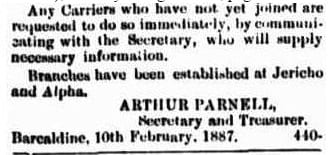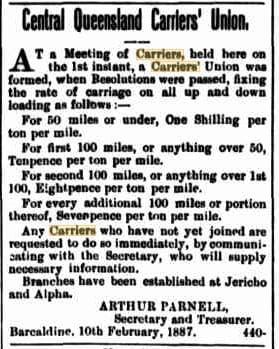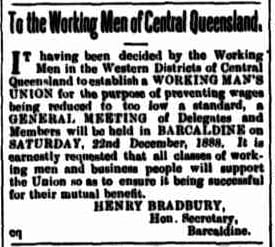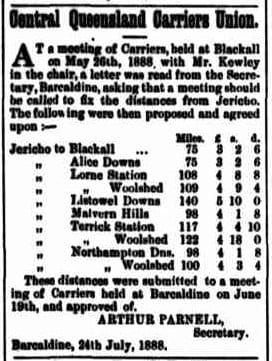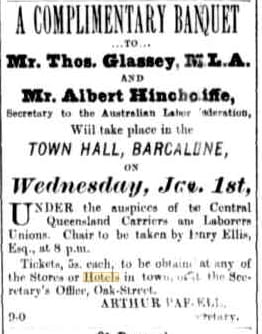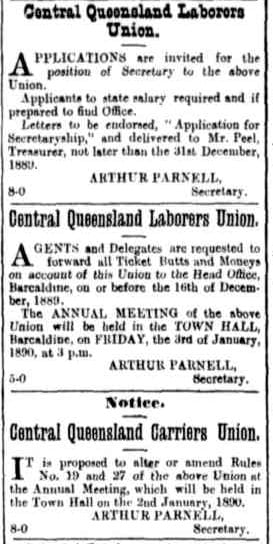Text Source: Hoch, Isabel. 2008. Pages 17, 18, 23, 25
Unionism in Barcaldine began with carriers. The town was oversupplied with teamsters because the railway had taken over much of their livelihood and only a few could secure good contracts.
From earliest days of Barcaldine township, discontent mounted as teams milled about on the sandy ridge, vying with each other for work. Near the railway station under a spreading gum tree, meetings began to take place and the idea of forming a union was born.
In February 1887, with commission agent, A.H. Parnell as chief promoter and inaugural chairman the Central Queensland Carriers’ Union was launched. Within a month it had almost 100 members and was being hailed as a ‘great success’. At the same time a Queensland Shearers’ Union resulted from a public meeting in Blackall and fast gathered supporters. Its first secretary was Pennyquick but Bill Kewley, who soon replaced him and kept the position for 20 years is better known. A year after its formation the Shearers’ Union, with 1,300 registered members and over £1,000 in the bank, was called ‘the most flourishing institution on the Barcoo’.
In October 1888, a working man’s union was reported in the newspapers to have enrolled over 1,000 members, although it was not due for official recognition until the end of December. Registered early in 1889 as the Central Queensland Labourers’ Union with a head office in Barcaldine, it appointed Henry Bradbury as secretary.
There were many attempts (some more successful than others) to form unions in other districts at other times. First meetings of the Central Queensland unions were conciliatory, with employers invited to attend, but before long the movement was reported to have the whole district ‘on the hum’.
In Brisbane a Trades and Labour Council formed in 1885 and in 1889 it became the Australian Labour Federation. Union leaders, Glassey and Hinchcliffe toured the country for support and in 1890 the movement set up its own newspaper, The Worker.
The union movement had three main aims: to improve working conditions, set standard rates of pay and to get rid of coloured labour. The Shearers’ and Labourers’ unions wrote into their rules: No Chinese, Japanese, South Sea Islanders or other coloured races are to be allowed to join the union. It was a rule from which the White Australia Policy grew.
In April 1889, alarmed by the powers unions were assuming, the pastoralists gathered in Barcaldine. Andrew Crombie, who convened the meeting, found the yards of hotels crowded with vehicles as station men came in from all over western Queensland. Before they dispersed, a Pastoral Employers Association was formed with F. R. Murphy, MLA for Barcoo, as president and Sydney Sharwood of Aramac Station, as secretary.
The Association grew and amalgamated with various groups in the south to become the United Pastoral Association (and ultimately, the United Graziers’ Association).
The pastoralists wanted to reduce rates of payment for shearing and refused to discuss their terms with union representatives.
A union delegate, W. Gay, travelled throughout the west rallying membership and by late in 1889 newspapers reported over 3,000 members in the Shearers’ Union and 2,250 in the Labourers’ Union. A Barcaldine reporter predicted in September 1889 that there would be a
desperate encounter between capital and labour in this district which may result in serious trouble throughout the colony.
In January 1891 the unions gathered again in Barcaldine for annual meetings, with an air of great purpose. The town was extremely lively and money was plentiful. Pastoralists had drawn up a Freedom of Contract form to be used in all sheds which would allow men to be engaged free of union rules. Shearers and shed hands were determined to resist it. The District Council of the Shearers’ Union combined with the Labourers Union to set up an office in Ash Street as strike committee headquarters. When the first sheds attempted to sign on for the new season, shearers refused the Freedom of Contract and members of the Labourers’ Union refused to work in sheds employing Chinese. What became known as The Great Shearers’ Strike of 1891 had begun.
After the strike ended in 1891, representations of shearers and pastoralists held a conference and worked out an uneasy peace. Pastoralists agreed to recognise the union but reserved the right to employ non-union workers. Both parties agreed to limit employment of coloured labour.
The Shearers’ Strike and the dramatic happenings around a large gum tree near Barcaldine railway station marked the beginning of the working man’s voice in Queensland politics. The tree soon became known as the Tree of Knowledge.

